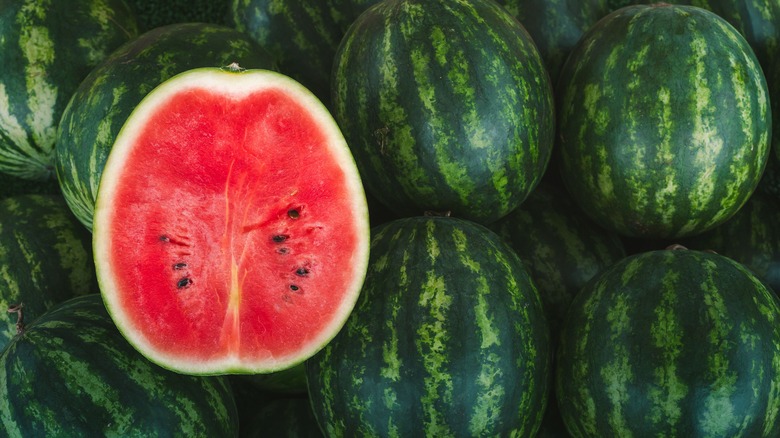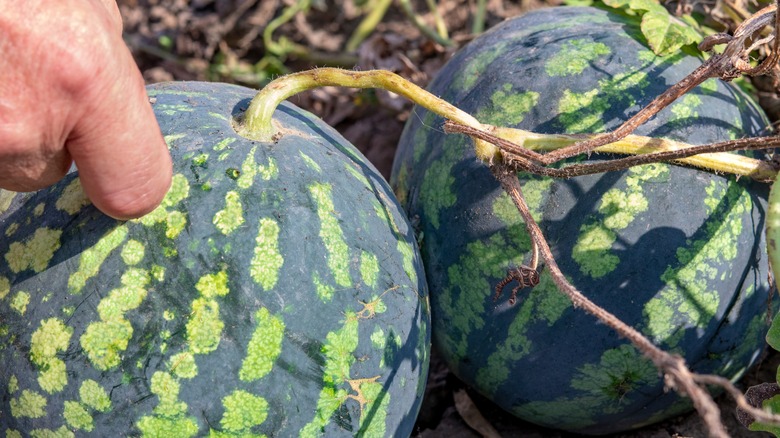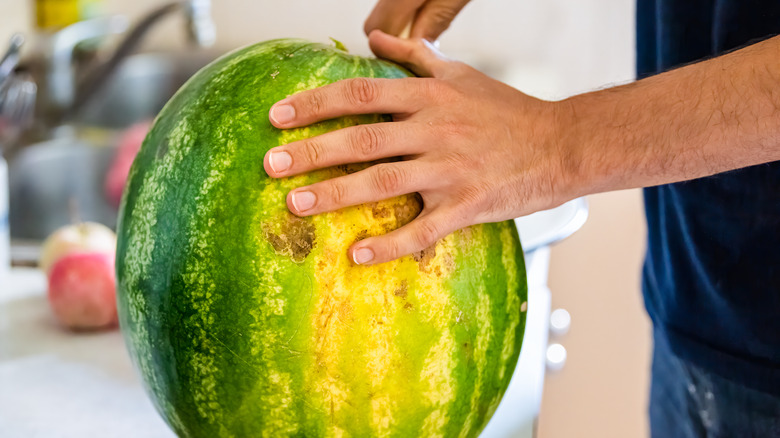To Pick The Ripest Watermelons, Use The 2-Finger Trick
A watermelon should be juicy enough to make a mess, but sweet enough that you don't even mind. Biting into the crunchy sweetness of one is an experience not many other foods can replicate. While you can find seedless watermelons (which aren't actually seedless) or even expensive small-batch watermelons to enhance the experience, it usually comes down to finding a solid specimen in a supermarket bin. Fortunately, that's not something you have to leave to chance.
Most fruits and vegetables have a trick to test for taste, quality, and freshness. Watching a pro in the produce aisle smelling and prodding ingredients makes it seem like they've got a secret language, and that sort of is the case. There are several tricks for picking out the ripest watermelons, but the simplest is the 2-finger trick — a maneuver you can do without even picking up a heavy melon.
All you need to look for are even light and dark green stripes on the rind, and each stripe should be the width of two fingers. If a watermelon passes that check, you've likely got yourself a winner. Combine it with a few other simple checks if you want to be rigorous, and you'll be cutting open a juicy, bright red melon in no time.
It's all in the fingers
The first check to apply to any prospective watermelon is the 2-finger trick. Check the stripes running lengthwise along the melon and ensure they are even and alternating between light and dark green. Then, around the middle of the fruit, where they're at their widest, lay two fingers over one of the dark green stripes; the stripe should be about the width of your index and middle fingers held together. If the stripe is wider than two fingers, that's fine, too.
Once it passes this initial check, you know that the watermelon is ripe. To ensure it's not overripe or dried out, rap the watermelon with your knuckles or flick it and listen for its timbre. A dull, hollow sound means the fruit may be past its prime; if the sound is a deep ringing note, it's perfectly ripe. Knowing which watermelon "sounds" right may require a bit of practice, but tap a few, and you'll hear the difference between them. And if you're still in doubt about your chosen watermelon's tenor, don't worry — there are a few more cues you can use to be totally sure.
Combine the two-finger trick with these checks
If you're having difficulty deciding if the watermelon sounds right when knocked, or if you come across a variety that doesn't have stripes, look for the watermelon's field spot, which marks the part of the fruit that touched the field as it grew and, therefore, didn't get exposed to sunlight (hence, the discoloration). A ripe watermelon has a large fieldspot that is yellow. If the spot is white or small, chances are the fruit was plucked before it fully ripened.
Similarly, check for "webbing" or watermelon scars, which look like brown scratches on the rind. More scarring is good because it signifies that more bees pollinated the flower, meaning that the resulting fruit is sweeter. And speaking of counterintuitive visuals, a dull watermelon will almost always taste better than a shiny one, the latter being a sign that it is underripe.
Once the watermelon has passed these checks, you can pick it up, conveniently making for one final test — heaviness. Since the fruit is 92% water, the heavier the watermelon, the more water it holds and, therefore, the juicier it will be.
So, now you know the produce aisle language, at least for watermelons. You don't need all the checks every time; sometimes, just the two-finger tip suffices. But with these other tricks up your sleeve, you'll never be in doubt about having picked the ripest, juiciest watermelon.


